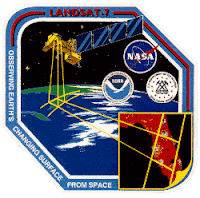NASA & NOAA - Landsat-7 Mission patch.
Feb. 7, 2017
The Larsen Ice Shelf is situated along the northeastern coast of the Antarctic Peninsula, one of the fastest-warming places on the planet. In the past three decades, two large sections of the ice shelf (Larsen A and B) have collapsed. A third section (Larsen C) seems like it may be on a similar trajectory, with a new iceberg poised to break away soon: http://earthobservatory.nasa.gov/IOTD/view.php?id=89257
Image above: The rift in Larsen C measures about 100 meters (300 feet) wide and cuts about half a kilometer (one-third of a mile) deep—completely through to the bottom of the ice shelf. While the rift is long and growing longer, it does not yet reach across the entire shelf. When that happens, Larsen C will shed an iceberg about the size of Delaware.
The mosaic above, centered on the northern part of Larsen Ice Shelf, is comprised of four natural-color satellite images captured by the Operational Land Imager (OLI) on Landsat 8 on Jan. 6 and 8, 2016. It shows the remnant of Larsen B, along with the Larsen A and smaller embayments to the north covered by a much thinner layer of sea ice. The remaining shelf appears white with some deep rifts within it.
Larsen crack 2016, animation by Sentinel-1 (ESA)
Areas with sea ice anchored to the coastline or ice shelf—fast ice—are light blue where covered with melt water and white where covered by wind-blown snow. The ocean is dark, nearly black, where it is not covered by sea ice. The white areas near where glaciers meet the sea have multitudes of small icebergs called bergy bits that broke off from land ice.
Extended caption and annotated images: NASA's Earth Observatory: http://earthobservatory.nasa.gov/IOTD/view.php?id=89588
Landsat: http://www.nasa.gov/mission_pages/landsat/main/index.html
Images Credits: NASA Earth Observatory image by Jesse Allen, using Landsat data from the U.S. Geological Survey/Caption: Adam Voiland/Text: Sarah Loff/Animation: ESA.
Greetings, Orbiter.ch




